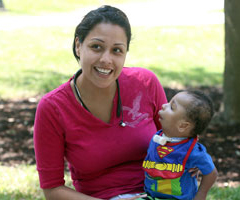Síndrome de Nager

Resumen
Las disostosis acrofaciales incluyen un grupo heterogéneo de enfermedades con hipoplasia radial, denominado como Síndrome de Nager, con una incidencia muy baja no precisada. Este síndrome se caracteriza por presentar una facie peculiar, acompañado de defectos congénitos que involucran el radio, por lo tanto las extremidades superiores. En este trabajo se describe un paciente con características fenotípicas que recuerdan el síndrome. Se realizó revisión del tema, se logró realizar el diagnóstico clínico, posibilitando el asesoramiento genético.
Palabras clave
Referencias
Bernier FP, Caluseriu O, Ng S, Schwartzentruber J, Kati J, et al. Haploinsufficiency of SF3B4, a Component of the Pre-mRNA Spliceosomal Complex, Causes Nager Síndrome. Am J Hum Genet. 2012 May 4; 90(5): 925–933. Disponible en: http://www.ncbi.nlm.nih.gov/pmc/articles/PMC3376638/pdf/main.pdf.
Shahin Abdollahi Fakhim, Nikzad Shahidi, Mehrnoush Mousaviagdas. A Case Report: Nager Acrofacial Dysostosis. Iran J Otorhinolaryngol. 2012 Winter; 24(66): 45–50. Disponible en: http://www.ncbi.nlm.nih.gov/pmc/articles/PMC3846201/.
Castori M, Bottillo I, D'Angelantonio D, Morlino S, De Bernardo C et al. A 22-Week-Old Fetus with Nager Syndrome and Congenital Diaphragmatic Hernia due to a Novel SF3B4 Mutation. Mol Syndromol. 2014 August; 5(5): 241–244. Disponible en: http://www.ncbi.nlm.nih.gov/pmc/articles/PMC4188155.
Bozatlıoğlu R, Münevveroğlu AP. Dental Management of a Patient with Nager Acrofacial Dysostosis. Case Rep Dent. 2015; 2015: 984732. Disponible en:http://www.ncbi.nlm.nih.gov/pmc/articles/PMC4617421/.
Rohit Malik, Sumit Goel, Saurabh Aggarwal. Limbal dermoid in Nager acrofacial dysostosis: A rare case report. Indian J Ophthalmol. 2014 March; 62(3): 339–341. Disponible en: http://www.ncbi.nlm.nih.gov/pmc/articles/PMC4061675/.
Thompson E, Cadbury R, Baraitser M. The Nager acrofacial dysostosis syndrome with the tetralogy of Fallot. J Med Genet. 1985 October; 22(5): 408–410. Disponible en: http://www.ncbi.nlm.nih.gov/pmc/articles/PMC1049491/pdf/jmedgene00097-0080.pdf.
Taksande A, Vilhekar K. Oculoauriculovertebral Spectrum with Radial Anomaly in Child. J Family Med Prim Care. 2013 Jan-Mar; 2(1): 92–94. Disponible en: http://www.ncbi.nlm.nih.gov/pmc/articles/PMC3894007/.
Weaver KN, Noack Watt KE, Hufnagel RB, Navajas Acedo J,et al. Acrofacial Dysostosis, Cincinnati Type, a Mandibulofacial Dysostosis Syndrome with Limb Anomalies, Is Caused by POLR1A Dysfunction. Am J Hum Genet. 2015 May 7; 96(5): 765–774. Disponible en: http://www.ncbi.nlm.nih.gov/pmc/articles/PMC4570288/.
Aadithya B Urs, Priya Kumar, Kalpana Nunia. Orodental findings in postaxial acrofacial dysostosis. J Oral Maxillofac Pathol. 2014 Jan-Apr; 18(1): 149. Disponible en: http://www.ncbi.nlm.nih.gov/pmc/articles/PMC4065437.
Trainor PA, Andrews. BT Facial Dysostoses: Etiology, Pathogenesis and Management. Am J Med Genet C Semin Med Genet. 2013 November; 163(4): 10.1002/ajmg.c.31375. Disponible en: http://www.ncbi.nlm.nih.gov/pmc/articles/PMC3870197/.
Copyright (c) 2016 Elayne Esther Santana Hernández

Esta obra está bajo una licencia de Creative Commons Reconocimiento-NoComercial-CompartirIgual 4.0 Internacional.




 La revista está: Certificada por el CITMA
La revista está: Certificada por el CITMA